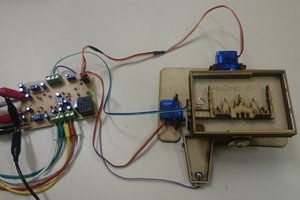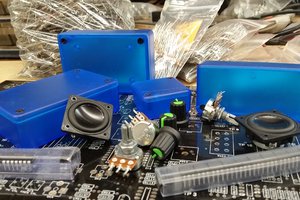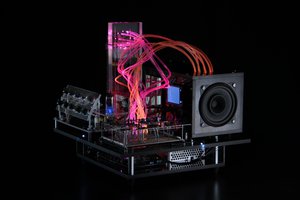Electronics
BF8's electronics consist of four stages:
- Clock
- Counter
- Synthesizer
- Amplifier
Clock pulses are supplied by a 555 timer. The clock drives a 4017 decade counter whose outputs are switched and attenuated before being connected to the synthesizer. The synthesizer stage is another 555 timer used to generate a square wave. The output of the synthesizer is fed into an LM386-based amplifier stage which terminates in a small speaker.
Controls
Two large knobs on the side of the box are used to control the speed of the sequencer and the volume level. The volume knob also has switch to turn the box on and off. There should be a way to start/stop the sequence, but I haven't decided on a good place to put that yet.
Each step contains a collection of identical controls:
- Trigger
- Triggered indicator
- In/out
- Level ("vc")
The trigger button simulates the actuation of a step, this can be used to tune the level/vc setting. The triggered indicator lights when the step is turned on by the sequencer (i.e., the note is played). The in/out switch enables or disables a step and the level knob sets the voltage fed to the synthesizer when the step is triggered.
Additional controls may be added to modify the behavior of the synthesizer stage. The simple 555 square wave generator can be controlled exclusively by setting the level knob on each sequencer step, but if a more flexible synthesizer stage is employed there may be more options.
Input/Output
Output is primarily through an internal speaker. Additionally headphone or line-out jacks may be added (if they can be safely). In addition to signal-out, jacks may be added to allow one BF8 to be connected to another to add more steps to the sequencer, create a "stereo pair" or support multiple, synchronized voices.
These options may create too much complexity or result in design challenges (how do you keep crayons from being jammed into 1/4" jacks?) but it would be cool to allow for expandability/hackability somehow.
 jason.gullickson
jason.gullickson
 Gabriel D'Espindula
Gabriel D'Espindula
 John Schuch
John Schuch
 Russell Kramer
Russell Kramer